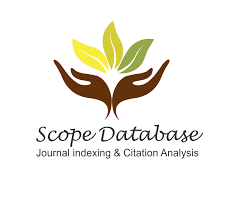Details
Flood Vulnerability Study of Oha River Basin, Nigeria
Ibiyemi Abisola JESULEYE
Cooperative Information Network (COPINE), Advanced Space Technology Application Laboratory (South-West) National Space Research and Development Agency (NASRDA), Ile-Ife, Nigeria
Bowale Ayodeji BABALOGBON
Cooperative Information Network (COPINE), Advanced Space Technology Application Laboratory (South-West) National Space Research and Development Agency (NASRDA), Ile-Ife, Nigeria
Download PDF http://doi.org/10.37648/ijrst.v13i03.006
http://doi.org/10.37648/ijrst.v13i03.006
Abstract
The increasing episodes of flood bringing about enormous damage to lives and properties in different parts of South-western region of Nigeria, served as a key rationale for this study. It thus mapped out a pragmatic plan to measure the spatial attributes and factors aggravating the impact of flood in Oha River basin, one of the major sub-basins in the region, as a contribution to the basic data sets, frame, and baseline information required to mitigate the devastating impact of flood in South-western Nigeria. The study delineated Oha river basin as a sub-basin from the regional basin, generated some thematic datasets (such as drainage, elevation/height, and soil) and produced flood vulnerability rating map of the basin. Multi-Criteria Decision Methods (MCDA) technique was employed using an indigenous software, SAVEMACE, to model the vulnerability case while Geographic Information System (GIS) environment was used to prepare the data and also present the visualisation of the vulnerability results. The factors considered in MCDA analysis were Elevation, Distance to Stream, Slope, Rainfall, Land Use Land Cover (LULC) and Soil. The results from the flood vulnerability modelling showed that 4.34% of the study area was least vulnerable to flooding, 37.28% was found marginally vulnerable, 55.73% was moderately vulnerable while 2.65% was found to be Highly vulnerable to flooding. The established degree of vulnerability of Oha basin to flood disaster would provide a framework for effective resources allocation to flood monitoring and control in the area.
Keywords: Oha basin; Nigeria; MCDA; GIS; Flood; Vulnerability
References
- Altan, O., Backhaus, R., Boccardo, P. and Zlatanova, S. (Eds.). (2010). Geoinformation for Disaster and Risk Management: Examples and best practices. Vienna, Austria: Joint Board of Geospatial Information Societies (JB-GIS).
- Wizor, C.H. and Week, D.A., 2014a, Impact of the 2012 Nigeria flood on emergent cities of Nigeria: The case of Yenagoa, Bayelsa State. Civil and Environmental Research 6(5), 31–40.
- Ishaya S. Mapping flood vulnerable areas in a developing urban center of Nigeria. Journal of sustainable Development in Africa. 2009;11(4):180-194.
- Nkeki F, Henah P, Ojeh V. Geospatial techniques for the assessment and analysis of flood risk along the Niger-Benue Basin in Nigeria. Journal of Geographic Information System. 2013;5(2):123-135. DOI: 10.4236/jgis.2013.5201
- Chima GN, Ogbonna CE, Ekpenyong US. Floods: Socio-economic costs and mitigation strategies. In G.N Chima, A.I Kalu (Eds). Contemporary Issues in Environmental Sciences, Uturu. Abia State University Press; 2010.
- Intergovernmental Panel on Climate Change (IPCC) (2007). Disaster Risk Reduction, Climate change Adaptation and Human security. IPCC, 2007.
- Amangabara, G. and Obenade, M. (2015). Flood vulnerability assessment of Niger Delta States, relative to 2012 flood disaster in Nigeria. American Journal of Environmental Protection, Vol. 3(3); 76-83. doi: 10.12691/env-3-3-3.
- Chukwuorji, J. C., & Ifeagwazi, C. M. (2015). 2012 Nigeria flood disaster: A critical evaluation and future research directions. International Journal of Communication, Vol.16; 1-15.
- Papaioannou, G., Vasiliades, L. and Loukas, A. (2015). Multi-criteria analysis framework for potential flood prone areas mapping. Water resources management, 29(2), 399-418.
- Kazakis, N., Kougias, I. and Patsialis, T. (2015). Assessment of flood hazard areas at a regional scal&e using an index-based approach and Analytical Hierarchy Process: Application in Rhodope–Evros region, Greece. Science of the Total Environment, 538, 555-563.
- Dandapat, K. and Panda, G.K. (2017). Flood vulnerability analysis and risk assessment using analytical hierarchy process. Modeling Earth Systems and Environment, 3(4), 1627-1646.
- Saaty, T.L. and Vargas, L.G. (1991). Prediction, projection, and forecasting: applications of the analytic hierarchy process in economics, finance, politics, games, and sports. Kluwer Academic Pub.
- Saaty, T. L. (1990). How to make a decision: the analytic hierarchy process. European journal of operational research, 48(1), 9-26.
- Luu, C., Von Meding, J. and Kanjanabootra, S. (2018). Assessing flood hazard using flood marks and analytic hierarchy process approach: a case study for the 2013 flood event in Quang Nam, Vietnam. Natural Hazards, 90(3), 1031-1050.
- Hoque, M.A.A., Tasfia, S., Ahmed, N. and Pradhan, B. (2019). Assessing Spatial Flood Vulnerability at Kalapara Upazila in Bangladesh Using an Analytic Hierarchy Process. Sensors, 19(6), 1302.
- Office of the Surveyor General of the Federation. (2012). Nigeria.
- World Bank Group. (2021). Climate Change Knowledge Portal. https://climateknowledgeportal.worldbank.org/country/nigeria/climate-data-historical. Retrieved: July 1, 2023.
- MapsOfWorld. (2023). https://www.mapsofworld.com/nigeria/weather.html. Retrieved :July 1, 2023.
- Agboola S. A. (1979). An Agricultural Atlas of Nigeria, Oxford University Press, Nigeria. . 248.
- Strahler, A. N. (1964). Quantitative geomorphology of drainage basins and channel networks. In V.T. Chow (Ed.), Handbook of Applied Hydrology (pp. 439-476). New York: McGraw-Hill Book Company.
- Abbas J. (2012). Geology and soil conditions as factors in flooding. Journal of Riparian Ecology. Vol. 3(1):213-220.











